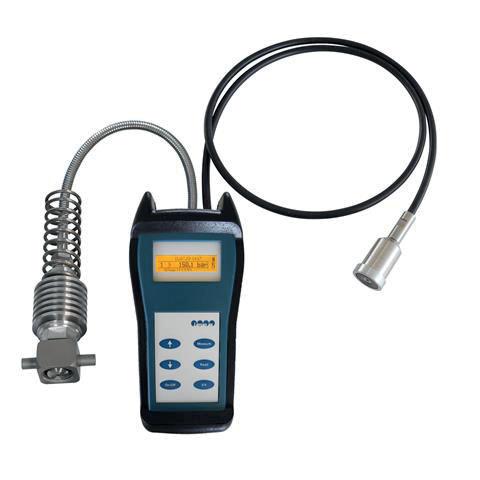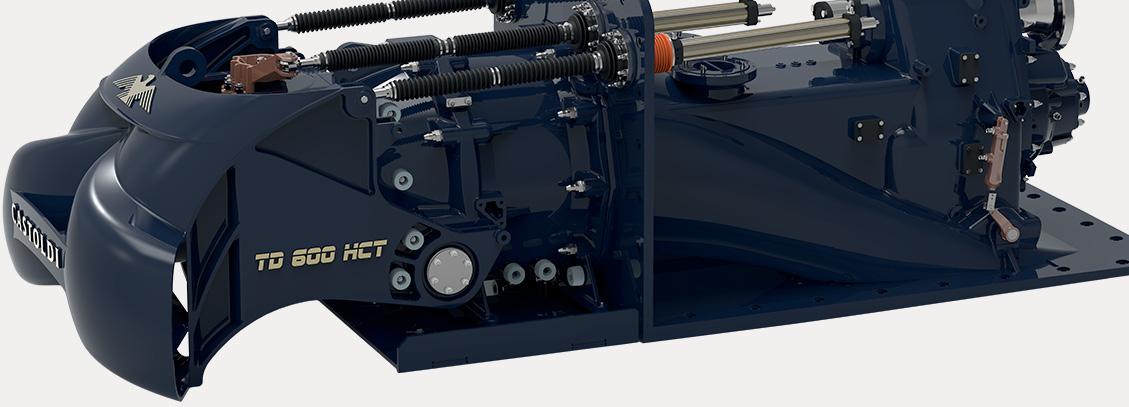
14 minute read
Doubling up on alt fuels
WinGD ALT FUELS RESEARCH PICKS UP MOMENTUM
Andreas Schmid, WinGD’s General Manager Future Technologies, discussed progress in developing combustion solutions to use ammonia or methanol as fuel in the engine designer’s dual-fuel engines
When Klaus Heim, ceo of WinGD, told The Motorship in November 2021 that the Winterthur-based engine designer would bring methanol and ammonia-fuelled engines to market by “2024-2025”, the extremely short timescale was almost as noteworthy as the company’s ambition to develop multiple alternative fuel engine platforms in parallel.
Andreas Schmid found time during the recent NorShipping conference to provide an update on the solid pace of WinGD’s engine development projects.
Schmid began by offering a high-level description of the research team’s approach to mapping out the introduction of a new fuel, which begin from first principles.
“As longtime members of the EU Hercules project, our understanding of alternate fuels goes back nearly two decades. We closely study the combustion properties of various alternate fuels within our labs which provides us with a solid understanding of who these fuels will interface with existing engine technology. We begin by understanding how the fuel burns, and then by identifying what we need to do to ensure that the fuel burns in the way we want it to. This influences the hardware requirements, and then we connect them up to the rest of the ship to make sure that this fits perfectly into each vessel.”
Turning to WinGD’s methanol research, Schmid notes that methanol – which is basically one molecule with a few smaller molecules – is “rather clean, compared with fuel oil, which is highly complex and sticky and contains hundreds of different components, each of differing lengths with their own boiling curves”.
Diesel cycle concept
Schmid confirmed that WinGD had selected a Diesel cycle concept for new or retrofitted methanol engines, although the final choice would be influenced by other considerations, such as the emissions profile. Physical tests are ongoing as an essential step to test some of the combustion concepts identified by the combustion simulations.
Combustion research to optimising the combustion of methanol is going to be carried out on the engine designer’s single cylinder engine in Winterthur in 2022. “Some of the research will also help us to improve the combustion itself as a key goal” Schmid said, “we know that these new fuels will come at a high price so optimising the combustion is essential for our customers before methanol can be considered a viable choice”, adding that WinGD would be leveraging its in-house expertise with the spray combustion chamber later in 2022.
One of the advantages of conducting the spray chamber combustion tests with methanol in-house is that the test data can be used to validate existing digitalised combustion model data (which is primarily based on 4-stroke combustion data).
Validating the commercial data was also likely to support the development work of Schmid’s colleagues who are looking at abatement solutions, and the overall environmental impact of the engine in a digital environment. Most importantly, it would also give an understanding of the engine concept’s expected fuel consumption and other performance parameters.
A separate team was assessing the hardware concept that the engine designer intended to select, although a final
8 WinGD was
conducting research into injection concepts for low-carbon fuels on its RTX-6 test engine in 2020.
decision was likely to be influenced by the final choice of combustion concept.
Schmid noted that today’s advanced digitalisation technology allowed for parallel progress for advancing the engine development. Some of the development of the methanol engine will occur in parallel, rather than in sequence, as Schmid understands was the case in previous alternative fuel engine developments.
“The pace of the industry’s advancement of alternate fuels today is remarkable when you consider how far we’ve come in a relatively short timeframe. It is exciting to be a part of this change and the pace is what we need to achieve the IMO’s GHG targets. In order to accelerate everything, we came up with a plan before we had the serial approach for the developments.”
Main test engine
Concurrently, WinGD engine designer was about to start engine tests on its main RTX-6 test engine at Winterthur – “our workhorse multi-cylinder test engine,” as Schmid described it. The entire engine will be converted to be capable of operating on methanol during the autumn of 2022.
The engine designer planned to start combustion tests on its main RTX-6 test engine at Winterthur by Q1 2023.
Turning to other aspects of the new fuel development, Schmid expressed cautious confidence that methanol would not pose significant challenges from a tribological perspective.
“I would say, if we burn it the right way, we don't expect to see many problems with the methanol.”
However, the engine designer was conducting its own research into the area, as most of the operational data for vessels operating on methanol was produced by vessels powered by 4-stroke engines.
Commercial and licensee considerations
One advantage of this development approach was that commercial, engine builder and ship-owner considerations were also directly considered by the project development team.
“This allows the project team to consider the pros and cons of different approaches, including the economics of different solutions, ease of manufacture, and so on. And then we identify customer, builder and supplier requirements.”
Similar considerations applied to discussions with individual customer. Schmid gave the example of fuel supply as a key constraint on customer specifications. “We have some customers who would like to order vessels without aftertreatment, on the understanding that they will operate on methanol most of the time. While this is exactly what the customer wants, we can see that it is not what he needs,” Schmid said.
“As the customer is not one of the major operators who will be able to secure significant volumes of methanol over the coming years, it is likely that they will have to operate on compliant fuels over the coming years. Therefore, we will probably go with an SCR or an EGR system, depending upon the individual customer’s needs and operational profile, and how often the vessel operates outside Tier III, etc. maintaining as much flexibility for our customers as possible.”
Potential methanol engine targets
Schmid noted the initial focus of the development programme would be on the engine sizes closest to its 52bore development engine in Winterthur, which would be the first engine to be added to the engine programme. “As soon as we know the concepts, we will look into how we can upscale to prepare. Shortly after 52, we will add the 62 and the 72. We will then look to add methanol versions of the 92 and 82 engines after the smaller engines are handed over.”
Ammonia development cycle
Turning to the second of the alternative fuels under development, Andreas Schmid noted that a number of similar research steps were being carried out for ammonia as a fuel.
WinGD has identified four different combustion concepts for its ammonia engine, including both Diesel cycle and Otto cycle concepts. The next step would be for the engine designer to shortlist two of the potential combustion concepts, with the intention of conducting combustion tests on the company’s single cylinder engine by Q3 2023.
In tandem, WinGD was developing its own ammonia combustion datasets. Unlike methanol, where commercial combustion model suppliers could draw on the operational data from 4-stroke engines, there is little data available for ammonia.
Here, WinGD was leveraging existing relationships In the field of primary research, working with academic partners, such as the Universite d’Orleans in France, and the ETH in Switzerland. The Universite d’Orleans was the first academic institution to publish ammonia combustion data in the last 40 years.
One particular focus for ammonia combustion research was how to minimise emissions of nitrous oxide, which as The Motorship has previously reported, is a highly potent GHG.
In passing, Schmid noted that while significant advances had been made in the accuracy of combustion models in recent years, the complexity of reproducing highly complex chemical processes meant that models were less accurate in estimating emissions.
Future Fuels Laboratory
Schmid notes that research into analysis of the combustion characteristics of ammonia have already begun in Winterthur. The engine designer is considering installing a second spray combustion chamber in its new dedicated low flashpoint fuels research laboratory in Winterthur, but is conducting research into ammonia in parallel with methanol at the moment.
Ammonia challenges
Schmid concluded by identifying a number of challenges for the development of an ammonia engine. The fuel itself has corrosive properties, and is also reactive to certain nonferrous metals, which has implications for materials selection.
Schmid also noted that the development of the system was likely to require slightly larger changes to the fuel injection system as well as changes to the turbocharger setup.
“There are also likely to be practical issues around the collection of scrape down samples from engines that have been running on ammonia.”

8 Andreas Schmid
VIBRATION SENSOR EXTENDS SCOPE OF ENGINE ANALYSIS
IMES, the cylinder pressure sensors and combustion control and monitoring systems specialist, has upgraded the vibration sensor on its EPM-XPplus engine analyser tool to broaden the range of parameters that the system can monitor
The existing EPM-XPplus tool allows engineers to detect potential problems by taking regular measurements during engine operations. The company noted that, without using the vibration sensor, the engineer can readily identify deviations by comparing results with indicator diagrams for the mean indicated pressure (MIP), the peak pressure (Pmax) or compression pressure (Pcomp).
However, other potential issues are harder to identify simply by comparison with indicator diagrams. IMES gives the examples of high-pressure fuel system failures where existing cylinder pressure indicator systems do not help to analyse the exact point of fuel injection. Similarly, it is challenging to precisely determine valve movements when faults with the inlet valve or exhaust valve controls occur.
By attaching the vibration sensor to the injector magnetically, the sensor records the point of lifting and landing of the injector needle as well as the beginning and ending of the fuel supply by the injection pump. The vibration sensor can be attached via a magnetic holder to the injector or pump, while the device’s measurement data will be processed by the EPMXPplus visualisation software. IMES notes that customers have achieved very good results by analysing the vibration diagrams in parallel with the indicator diagrams.
The vibration sensor as part of the engine analyser EPMXPplus extends the range of advanced diagnostic options available to engineers: 5 Phases of lifting and landing of the injector needle 5 Beginning and ending of the circulation of the heated heavy fuel in the fuel system 5 Phases of beginning of fuel supply and of shutdown of the high-pressure pump 5 Phases of closing and (in some cases) of opening of the gas distribution valves
The vibration monitoring approach also fulfils the requirements of the marine classification societies regarding non-destructive testing as there is no need for mechanical intervention on the engine during the installation of the vibration sensor.

8 The EPM-XPplus with vibration sensor
J-ENG sees rising demand for UEC42LSH orders
The UEC42LSH engine is attracting signifi cant commercial interest in Japan and the Chinese market, according to Japan Engine Corporation (J-ENG).
J-ENG’s newest engine, which was launched in 2019 as a successor to J-ENG’s low-speed UEC45LSE design, has attracted attention from shipowners in East Asia. The first vessel to be powered by the UEC42LSH engines entered service in March 2022, following the delivery of the first engine unit in June 2021.
J-ENG has received a strong influx of new engine orders, driven by demand from the Handysize bulk carrier segment. In all, the engine builder has received orders for 30 orders, following on from the series order for six engines placed in 2020.
The UEC42LSH engine was designed with one eye on the requirements of Handysize bulk carriers and small-sized chemical tankers, which led to the engine builder optimising the overall space requirements for the engine.
However, the engine builder has also reported that a Chinese licensee, Guangzhou Diesel Engine Factory Co., Ltd. (GDF), has also received a significant number of orders since agreeing a license agreement with J-ENG in March 2022. GDF has already received orders for 20 units for various UEC42LSH and UEC50LSH Eco type engines, which are destined for vessels for Chinese coastal trades.
J-ENG noted that it now has three UE Engine licensees in China, including the existing China Shipbuilding Industry Corporation Diesel Engine Co., Ltd. (CSE) and Zhejiang Yungpu Heavy Machinery Co., Ltd. (YHM).
The engine builder identified the new high efficiency and brake mean effective pressure (BMEP) of the engine as key selling points, along with the engine’s competitive fuel efficiency. In Tier 2 operation, the UEC42LSH can achieve a fuel consumption rate of 164 g/ kWh at maximum rating. The overall space requirements for the engine have been reduced, while the engine’s fuel efficiency at slower operating speeds has been improved.
J-ENG hopes to further improve the engine’s fuel economy by fine-tuning the engine platform in response to feedback from the engine’s operational performance.
BRUNVOLL ADDS REMOTE CBM TO PORTFOLIO OF SOLUTIONS
Norway-based propulsion specialist Brunvoll has introduced a condition-based monitoring solution, BruCon Condition Monitoring, into its product portfolio
The solution off ers remote access to the condition of Brunvoll’s propulsion units and maneouvring thrusters via a web dashboard.
The solution itself was developed as part of a partially government-funded research project, FAST, which brought together compressor supplier Sperre Air Power AS, ship owner Altera Infrastructure and research partner SINTEF AS in 2019.
The project was intended to develop and implement a system where machine learning algorithms could be used to support condition monitoring and various types of condition/ predictive maintenance systems. The systems would supply actionable information that could contribute to decision making both onshore and offshore.
The project needed to develop solutions to a number of technical barriers, including the development of sensor data collection and compression solutions that could integrate sensor data from other suppliers’ systems aboard the vessel. The project also addressed the need to develop secure data transmission protocols to ensure the security of data transmission from vessel to shore.
At the same time, the project was focused on the development of artificial intelligence and machine learning tools that could analyse the datasets to identify opportunities to optimise the maintenance and operations of the assets.
Following the successful conclusion of the project, Brunvoll has created a data framework that allows live data from its equipment installed on vessels to be fed back to the Brunvoll data centre. Brunvoll can process the sensor and control system data, and integrate analytical insights produced by its machine learning algorithms, to produce condition indicators supplied via a customer portal and dashboard.
The system detects specific events and also monitors operational characteristics that have significance from an optimised maintenance and operations perspective.
This dashboard may also be integrated with the vessel’s planned maintenance system. In addition to the digital online services, Brunvoll is serving the clients through an Operations Centre at the Brunvoll Head Office staffed by Brunvoll specialists.

8 Brunvoll
Conditioning Monitoring System
Castoldi adds larger jet to portfolio
Castoldi is extending its product portfolio, introducing a larger version of its waterjet for the high-speed ferry, crew transfer vessel and off shore patrol vessel segments.
The new addition Castoldi’s portfolio, the Turbodrive 600 H.C.T., is designed for engines with power ranges from 500 kW up to 1,900 kW (2,700 HP). The waterjet is the first of its size to be equipped with an integrated gearbox (heavy duty certified) with up to 13 gear ratios available, matched to a multi-disc hydraulic clutch.
“We are proud to bring our expertise and product quality to the commercial marine sector through this launch,” said Giacomo Castoldi, owner, Castoldi.
Castoldi is an established supplier of waterjet propulsion solutions to the passenger and naval markets. The Italian waterjet supplier will be able to meet the requirements of high speed passenger vessels and interceptors following the launch of its larger capacity model. del.
The waterjet retains Castoldi’s innovative ClearDuct unclogging system (synchronizing operations of the impeller rotation reversing and the intake grid opening) and the integration with the interceptors. The steering and reversing actuators have been designed to manage the high forces involved with two hydraulic cylinders controlling the movement of the bucket. This allows rapid and efficient crash-stops and one cylinder dedicated to the steering nozzle for greater dynamic efficiency.
The launch follows shortly after Castoldi announced one of the largest orders in its recent history, for a series of local ferries that will be built at the Maldives Shipyard of UAE shipyard Gulf Craft. The contract will see the Italian supplier supply over 164 Turbodrive 400 H.C. waterjets to the Maldives Shipyard in connection with an order for 82 Gulf Craft Touring 51 ferries. The ferries will be operated by Maldives Transport and Contracting Company (MTCC).
The first four vessels were officially handed over by Gulf Craft to MTCC in January 2022. They are currently undergoing route and schedule testing before ferry services officially begin.
Gulf Craft is now developing a new production facility dedicated to the manufacturing of vessels for use in the Indian Ocean which will see its operations and production capacity double within 16 months.






